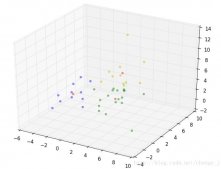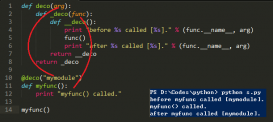我就废话不多说了,大家还是直接看代码吧~
|
1
2
3
4
5
6
7
8
9
10
11
12
13
14
15
16
17
18
19
20
21
22
23
24
25
26
27
28
29
30
31
32
33
34
35
36
37
38
39
40
41
42
43
44
45
46
47
48
49
50
51
52
53
54
55
56
57
58
59
60
61
62
63
64
65
66
67
68
69
70
71
72
73
74
75
76
77
78
79
80
81
82
83
84
85
86
87
88
89
90
91
92
|
import torchimport torch.nn as nnimport torch.nn.functional as F class VGG16(nn.Module): def __init__(self): super(VGG16, self).__init__() # 3 * 224 * 224 self.conv1_1 = nn.Conv2d(3, 64, 3) # 64 * 222 * 222 self.conv1_2 = nn.Conv2d(64, 64, 3, padding=(1, 1)) # 64 * 222* 222 self.maxpool1 = nn.MaxPool2d((2, 2), padding=(1, 1)) # pooling 64 * 112 * 112 self.conv2_1 = nn.Conv2d(64, 128, 3) # 128 * 110 * 110 self.conv2_2 = nn.Conv2d(128, 128, 3, padding=(1, 1)) # 128 * 110 * 110 self.maxpool2 = nn.MaxPool2d((2, 2), padding=(1, 1)) # pooling 128 * 56 * 56 self.conv3_1 = nn.Conv2d(128, 256, 3) # 256 * 54 * 54 self.conv3_2 = nn.Conv2d(256, 256, 3, padding=(1, 1)) # 256 * 54 * 54 self.conv3_3 = nn.Conv2d(256, 256, 3, padding=(1, 1)) # 256 * 54 * 54 self.maxpool3 = nn.MaxPool2d((2, 2), padding=(1, 1)) # pooling 256 * 28 * 28 self.conv4_1 = nn.Conv2d(256, 512, 3) # 512 * 26 * 26 self.conv4_2 = nn.Conv2d(512, 512, 3, padding=(1, 1)) # 512 * 26 * 26 self.conv4_3 = nn.Conv2d(512, 512, 3, padding=(1, 1)) # 512 * 26 * 26 self.maxpool4 = nn.MaxPool2d((2, 2), padding=(1, 1)) # pooling 512 * 14 * 14 self.conv5_1 = nn.Conv2d(512, 512, 3) # 512 * 12 * 12 self.conv5_2 = nn.Conv2d(512, 512, 3, padding=(1, 1)) # 512 * 12 * 12 self.conv5_3 = nn.Conv2d(512, 512, 3, padding=(1, 1)) # 512 * 12 * 12 self.maxpool5 = nn.MaxPool2d((2, 2), padding=(1, 1)) # pooling 512 * 7 * 7 # view self.fc1 = nn.Linear(512 * 7 * 7, 4096) self.fc2 = nn.Linear(4096, 4096) self.fc3 = nn.Linear(4096, 1000) # softmax 1 * 1 * 1000 def forward(self, x): # x.size(0)即为batch_size in_size = x.size(0) out = self.conv1_1(x) # 222 out = F.relu(out) out = self.conv1_2(out) # 222 out = F.relu(out) out = self.maxpool1(out) # 112 out = self.conv2_1(out) # 110 out = F.relu(out) out = self.conv2_2(out) # 110 out = F.relu(out) out = self.maxpool2(out) # 56 out = self.conv3_1(out) # 54 out = F.relu(out) out = self.conv3_2(out) # 54 out = F.relu(out) out = self.conv3_3(out) # 54 out = F.relu(out) out = self.maxpool3(out) # 28 out = self.conv4_1(out) # 26 out = F.relu(out) out = self.conv4_2(out) # 26 out = F.relu(out) out = self.conv4_3(out) # 26 out = F.relu(out) out = self.maxpool4(out) # 14 out = self.conv5_1(out) # 12 out = F.relu(out) out = self.conv5_2(out) # 12 out = F.relu(out) out = self.conv5_3(out) # 12 out = F.relu(out) out = self.maxpool5(out) # 7 # 展平 out = out.view(in_size, -1) out = self.fc1(out) out = F.relu(out) out = self.fc2(out) out = F.relu(out) out = self.fc3(out) out = F.log_softmax(out, dim=1) return out |
补充知识:Pytorch实现VGG(GPU版)
看代码吧~
|
1
2
3
4
5
6
7
8
9
10
11
12
13
14
15
16
17
18
19
20
21
22
23
24
25
26
27
28
29
30
31
32
33
34
35
36
37
38
39
40
41
42
43
44
45
46
47
48
49
50
51
52
53
54
55
56
57
58
59
60
61
62
63
64
65
66
67
68
69
70
71
72
73
74
75
76
77
78
79
80
81
82
83
84
85
86
87
88
89
90
91
92
93
94
95
96
97
98
99
100
101
102
103
104
105
106
107
108
109
110
111
112
113
114
115
116
117
118
119
120
121
122
123
124
125
126
127
128
129
130
131
132
133
134
135
136
137
138
139
140
141
142
143
144
145
146
147
148
149
150
151
152
153
154
155
156
157
158
159
160
|
import torchfrom torch import nnfrom torch import optimfrom PIL import Imageimport numpy as npprint(torch.cuda.is_available())device = torch.device('cuda:0')path="/content/drive/My Drive/Colab Notebooks/data/dog_vs_cat/"train_X=np.empty((2000,224,224,3),dtype="float32")train_Y=np.empty((2000,),dtype="int")train_XX=np.empty((2000,3,224,224),dtype="float32")for i in range(1000): file_path=path+"cat."+str(i)+".jpg" image=Image.open(file_path) resized_image = image.resize((224, 224), Image.ANTIALIAS) img=np.array(resized_image) train_X[i,:,:,:]=img train_Y[i]=0for i in range(1000): file_path=path+"dog."+str(i)+".jpg" image = Image.open(file_path) resized_image = image.resize((224, 224), Image.ANTIALIAS) img = np.array(resized_image) train_X[i+1000, :, :, :] = img train_Y[i+1000] = 1train_X /= 255index = np.arange(2000)np.random.shuffle(index)train_X = train_X[index, :, :, :]train_Y = train_Y[index]for i in range(3): train_XX[:,i,:,:]=train_X[:,:,:,i]# 创建网络class Net(nn.Module): def __init__(self): super(Net, self).__init__() self.conv1 = nn.Sequential( nn.Conv2d(in_channels=3, out_channels=64, kernel_size=3, stride=1, padding=1), nn.ReLU(), nn.Conv2d(in_channels=64, out_channels=64, kernel_size=3, stride=1, padding=1), nn.ReLU(), nn.BatchNorm2d(num_features=64, eps=1e-05, momentum=0.1, affine=True), nn.MaxPool2d(kernel_size=2,stride=2) ) self.conv2 = nn.Sequential( nn.Conv2d(in_channels=64,out_channels=128,kernel_size=3,stride=1,padding=1), nn.ReLU(), nn.Conv2d(in_channels=128, out_channels=128, kernel_size=3, stride=1, padding=1), nn.ReLU(), nn.BatchNorm2d(128,eps=1e-5,momentum=0.1,affine=True), nn.MaxPool2d(kernel_size=2,stride=2) ) self.conv3 = nn.Sequential( nn.Conv2d(in_channels=128, out_channels=256, kernel_size=3, stride=1, padding=1), nn.ReLU(), nn.Conv2d(in_channels=256, out_channels=256, kernel_size=3, stride=1, padding=1), nn.ReLU(), nn.Conv2d(in_channels=256, out_channels=256, kernel_size=3, stride=1, padding=1), nn.ReLU(), nn.BatchNorm2d(256,eps=1e-5, momentum=0.1, affine=True), nn.MaxPool2d(kernel_size=2, stride=2) ) self.conv4 = nn.Sequential( nn.Conv2d(in_channels=256, out_channels=512, kernel_size=3, stride=1, padding=1), nn.ReLU(), nn.Conv2d(in_channels=512, out_channels=512, kernel_size=3, stride=1, padding=1), nn.ReLU(), nn.Conv2d(in_channels=512, out_channels=512, kernel_size=3, stride=1, padding=1), nn.ReLU(), nn.BatchNorm2d(512, eps=1e-5, momentum=0.1, affine=True), nn.MaxPool2d(kernel_size=2, stride=2) ) self.conv5 = nn.Sequential( nn.Conv2d(in_channels=512, out_channels=512, kernel_size=3, stride=1, padding=1), nn.ReLU(), nn.Conv2d(in_channels=512, out_channels=512, kernel_size=3, stride=1, padding=1), nn.ReLU(), nn.Conv2d(in_channels=512, out_channels=512, kernel_size=3, stride=1, padding=1), nn.ReLU(), nn.BatchNorm2d(512, eps=1e-5, momentum=0.1, affine=True), nn.MaxPool2d(kernel_size=2, stride=2) ) self.dense1 = nn.Sequential( nn.Linear(7*7*512,4096), nn.ReLU(), nn.Linear(4096,4096), nn.ReLU(), nn.Linear(4096,2) ) def forward(self, x): x=self.conv1(x) x=self.conv2(x) x=self.conv3(x) x=self.conv4(x) x=self.conv5(x) x=x.view(-1,7*7*512) x=self.dense1(x) return xbatch_size=16net = Net().to(device)criterion = nn.CrossEntropyLoss()optimizer = optim.Adam(net.parameters(), lr=0.0005)train_loss = []for epoch in range(10): for i in range(2000//batch_size): x=train_XX[i*batch_size:i*batch_size+batch_size] y=train_Y[i*batch_size:i*batch_size+batch_size] x = torch.from_numpy(x) #(batch_size,input_feature_shape) y = torch.from_numpy(y) #(batch_size,label_onehot_shape) x = x.cuda() y = y.long().cuda() out = net(x) loss = criterion(out, y) # 计算两者的误差 optimizer.zero_grad() # 清空上一步的残余更新参数值 loss.backward() # 误差反向传播, 计算参数更新值 optimizer.step() # 将参数更新值施加到 net 的 parameters 上 train_loss.append(loss.item()) print(epoch, i*batch_size, np.mean(train_loss)) train_loss=[]total_correct = 0for i in range(2000): x = train_XX[i].reshape(1,3,224,224) y = train_Y[i] x = torch.from_numpy(x) x = x.cuda() out = net(x).cpu() out = out.detach().numpy() pred=np.argmax(out) if pred==y: total_correct += 1 print(total_correct)acc = total_correct / 2000.0print('test acc:', acc)torch.cuda.empty_cache() |
将上面代码中batch_size改为32,训练次数改为100轮,得到如下准确率

过拟合了~
以上这篇利用PyTorch实现VGG16教程就是小编分享给大家的全部内容了,希望能给大家一个参考,也希望大家多多支持服务器之家。
原文链接:https://blog.csdn.net/qq_41563738/article/details/91346181












